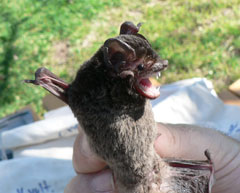
Bats need space in tree plantings

A study of bats on farms suggests that new approaches are needed to revegetation and that it should not be automatically assumed that planting of native trees will increase biodiversity.
NSW Department of Primary Industries forests researcher, Brad Law, says eucalypts are primarily planted on farms to stem land degradation and improve agricultural productivity.
“It is assumed these plantings will also improve nature conservation and biodiversity, when this is not necessarily the case”, Dr Law said.
“Very few Australian studies have investigated the use of native revegetation by fauna and the importance of such factors as the size, age or mix of trees or where they are located in the landscape.”
Dr Law’s research on how bats use eucalypt plantings in south-eastern Australia was part of a larger study of all terrestrial vertebrates by the Forest Biodiversity group at NSW DPI.
Undertaken across 120 sites, the bat study found many species were just as likely to fly through paddocks as they were revegetation sites.
“Most bat species need space to navigate, and their preference is open woodland, but old, large plantings are a close second.
“The reason for this is probably not the age or height of the trees but the fact that tree stands in older plantings are generally patchy, and have gaps because of trees dying through drought or use by cattle.
“Of course old trees are needed as well to provide hollows for roosting bats during the day.”
Dr Law said most bat species dislike clutter (dense vegetation) in a landscape.
“What the bats dislike is dense understorey cover that is typical of young fast growing plantings. Trees and bushes impede their echolocation, although bats are attracted to vegetation edges.
“The fact that many bats avoid clutter suggests that efforts to restore woodland communities should use lower stem densities or incorporate a mixture of densities.”
Suggestions to improve revegetation programs for bats include:
- Reducing tree density or maintaining a mosaic of densities and gaps. Small tracks large enough for a four-wheel drive to pass through are likely to provide space for bats to forage. Management practices that reduce clutter, such as thinning of high density stands, could also help.
- Planting larger areas, greater than 25 hectares, as these are used more by bats, especially after ten years.
- Retain paddock trees and incorporate these into plantings to provide a focus for foraging and a source of roosts in hollows.
- Include a dam, as bat activity is known to be high around water.
Dr Law said there was a great need to research the effect of revegetation on biodiversity.
“Existing recommendations of ways to improve biodiversity tend to be based on lessons learnt through studies of remnant bush.
“Given that trees are being planted on farms principally to rehabilitate the landscape rather than to increase biodiversity, there is a need to find out what biodiversity benefits accrue when the primary purpose of planting is other than nature conservation.”
Email:

